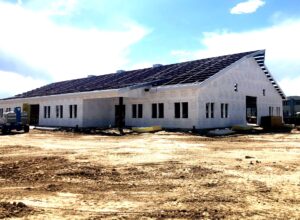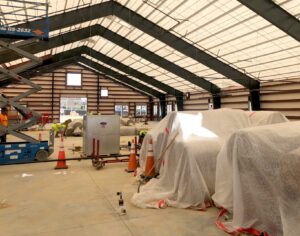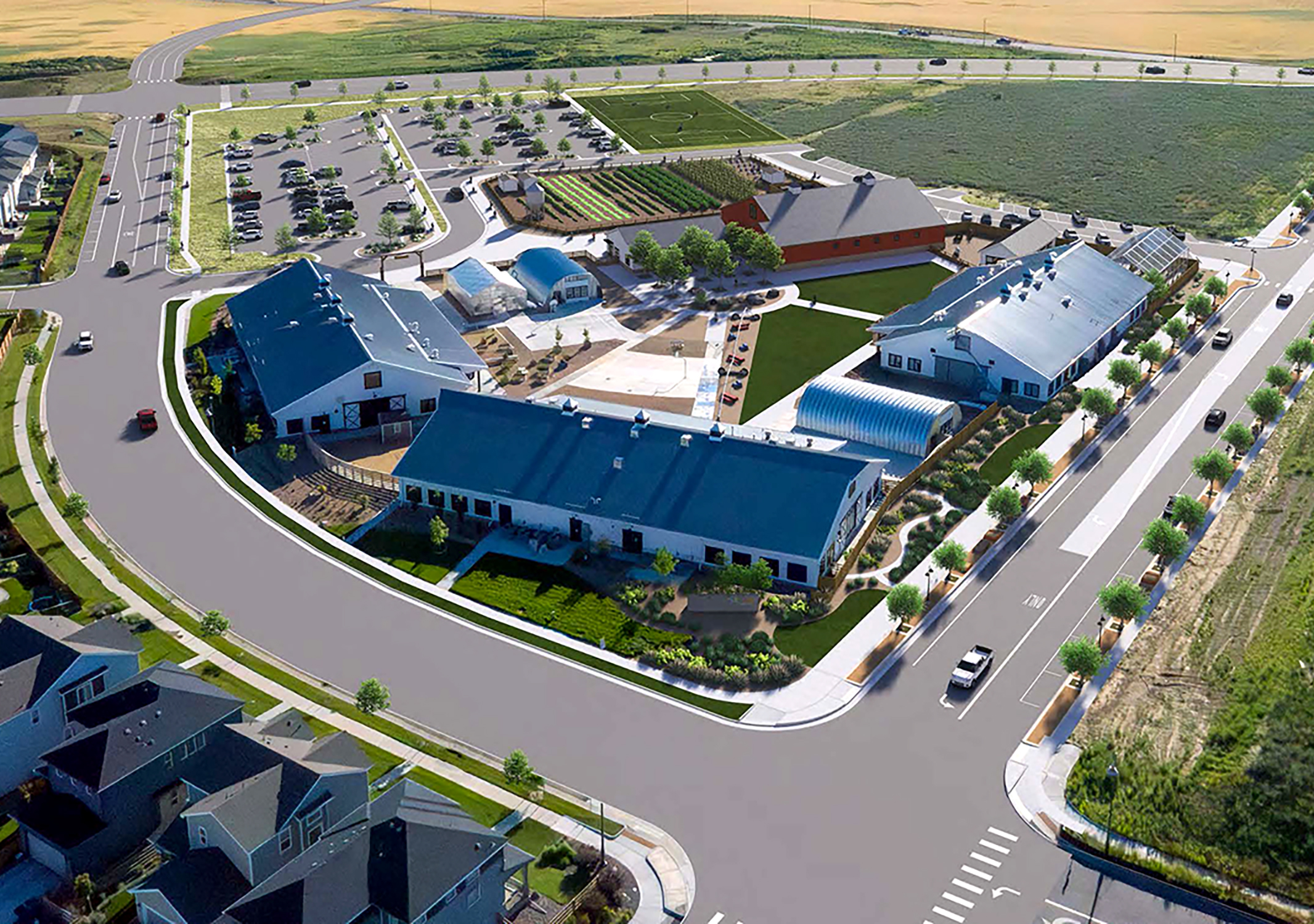Photo: Sunward Steel Buildings supplied the first five custom-engineered metal buildings for The STEAD School’s campus. | Photo Credit: Terracina Design
By Tony Bouquot
When Kelly Leid, co-founder of The STEAD School (STEAD) in Commerce City, Colo., had to construct five buildings in four years to launch a new, $32.3 million charter school, he chose custom-engineered metal buildings by Sunward Steel Buildings for several reasons. Having successfully used this technology for other building projects, he knew that metal buildings offered a streamlined construction process and were flexible, adaptable, durable and easy to maintain.
Streamlined Construction
The fact that STEAD’s capital campaign began shortly before the onset of the COVID-19 pandemic made developing a multi-phase schedule mandatory. After Leid secured a 10-acre site donation, a $2.75 million construction grant, and $1 million in in-kind entitlement and site preparation services, STEAD still needed to obtain private loans to cover the majority of construction costs.

Photo Credit: Kelly Leid
“The main lender, Vectra Bank, agreed to fund construction of the three academic buildings—Buildings 1, 2 and 3—as long as we hit specific attendance numbers,” Leid explained. “Using metal buildings streamlined the project delivery process, making this phased approach easier to manage. The metal building components could be fabricated for each building while permitting was underway and then shipped to the site on a just-in-time basis. Crews could rapidly assemble the steel structure and enclose each building. Fewer trades were needed on site, so less time (and money) was spent on project coordination.”
Later, when STEAD’s authorizing school district (J27) gave the school $10 million, STEAD’s leaders closed out its private loans and refinanced its debt. This process provided enough capital to build the Cultivate Center. The fifth building, the Danton Wirth Soils and Seed Lab, was donated by the project’s metal building manufacturer, Sunward Steel Buildings, to honor the company’s founder. Thus, STEAD’s first five campus buildings were completed before the first class of students graduated in May 2025.
Buildings Promote Educational Flexibility
STEAD’s co-founders knew the student-led, science-based learning model they’d developed would challenge the traditional lecture-based approach to STEM education—and that it would have an impact on the design of the school’s built environment.
“We wanted to collapse the idea of what high school has been by empowering students to experiment, collaborate and do big things,” Leid said.
For example, instead of conventional classrooms that have desks organized in rows facing forward, the learning spaces in STEAD’s academic buildings are wide open with soaring ceilings and abundant natural light.
Using metal building technology made constructing these tall, clear-span spaces possible. Students and teachers have the flexibility they need to arrange moveable furniture based on what is occurring within the lab-like spaces. The vaulted ceilings provide direct access to light fixtures, ductwork and other building system components, making these easy to maintain and repair.
Adaptability Promotes Intentional Culture
According to Leid, using metal buildings also helped STEAD leaders develop “an intentional culture” unique to this next-gen charter school. The first three academic buildings were designed to have “hard shells with soft middles” so that their interiors could be adapted to incorporate knowledge gained from experience and observations.
“We completed the first academic building without input from faculty or students because they didn’t exist yet,” Leid said. “We changed the interior layouts of Buildings 2 and 3 based on what we learned after Building 1 was occupied. For example, we reduced the amount of space for hallways and increased the size of learning areas. We also reconfigured spaces to make it easier to move produce from an adjacent production greenhouse to the teaching kitchen in Building 3.”
Cristian Manzur, senior design engineer for Sunward, pointed out that using metal buildings also made it easier to meet more rigorous code requirements.
“Building 1 was permitted under local codes but Buildings 2 and 3 were permitted by state code officials,” Manzur explained. “So, for example, the insulation requirements were more stringent for the second two academic buildings. Fortunately, metal building technology accommodates a double layer of insulation for both roof and walls.”
By combining exterior insulation with cavity insulation, engineers were able to update the design and achieve the higher U-value required by the 2021 IECC energy code. This double-layer system increases energy efficiency and offers better performance over varying temperatures.
Durability, Responsiveness and Sustainability

Photo Credit: Kelly Leid.
When Leid was the director of operations for Denver Public Schools he said the district’s goal was to construct buildings that would last 100 years. While durability and longevity remain important, school buildings must be able to respond to rapid changes in educational models and methods.
“STEAD’s buildings—if they are well-maintained—will last 50+ years,” Leid noted. “However, we can recalibrate the built interiors, move partition walls, update technology and make other changes within their hard exterior edges as new needs arise.”
Metal buildings’ durability and low maintenance requirements contribute to their longevity. They can be designed to withstand extreme weather conditions such as earthquakes and winds of up to 170 mph. Metal doesn’t support mold growth, rust or decay and (since it doesn’t contain cellulose or other plant materials) metal doesn’t attract termites, woodboring beetles or other pests. Metal is nonporous with a smooth surface that doesn’t absorb liquids or accumulate (hold) dirt and grime, meaning metal surfaces can be easily cleaned with mild soap and water. Protective coatings also resist corrosion, fading or discoloration and require less-frequent painting than other cladding materials.
The high tensile strength of metal roofs has been especially important for STEAD’s new Animal Science Center, which is designed to operate “off grid.” The building’s metal roof has been custom engineered to meet Colorado’s rigorous snow load requirements while supporting a full solar array that will generate electricity and feed it into a direct-current microgrid system. Using renewable energy will reduce operational costs while providing students who are studying environmental sciences to learn about sustainable technologies.
Praiseworthy Results
In 2022, Leid and STEAD cofounder, Amy Schwartz, were awarded the Colorado Civic Medal for Growth and Innovation on behalf of this “future-ready, next-generation, agriculturally grounded charter school.” For Leid, however, the true measure of success has been the positive comments he’s received from staff, faculty and students.
“The kids and teachers stay on campus after the end of the school day,” he said. “They love being there. This is a place where they feel welcome and inspired.”
Tony Bouquot is general manager of the Metal Building Manufacturer’s Association.


